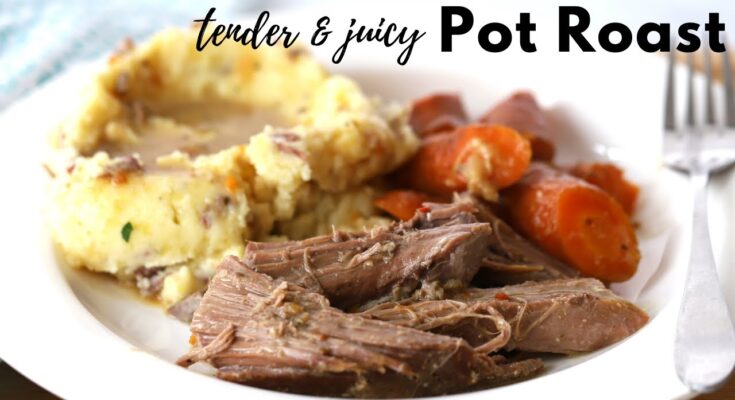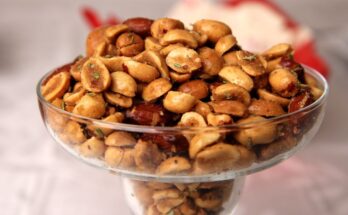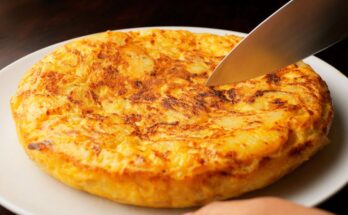Rump Roast Recipe: Rump roast is a comforting, hearty dish that’s perfect for any occasion, whether it’s a family dinner or a special celebration. This flavorful cut of beef, when cooked properly, transforms into a tender, melt-in-your-mouth meal that’s sure to impress. If you’ve ever wondered how to make the perfect rump roast, you’re in the right place.
In this step-by-step guide, I’ll walk you through everything you need to know, from preparation to plating. Ready? Let’s dive in!
Ingredients Needed for a Perfect Rump Roast
To make the perfect rump roast, you’ll need the right ingredients to build layers of flavor. Here’s what you’ll need:
Essential Ingredients:
- 3-4 pounds of rump roast.
- 2 tablespoons olive oil.
- 1 teaspoon kosher salt.
- 1 teaspoon black pepper.
- 2 teaspoons garlic powder.
- 1 teaspoon onion powder.
- 1 teaspoon smoked paprika.
Optional Additions:
- Fresh herbs (rosemary, thyme, parsley).
- 1 cup beef broth or red wine for added moisture.
- 2 tablespoons Worcestershire sauce.
Substitutions:
- Replace olive oil with avocado oil for a richer flavor.
- Use chicken stock instead of beef broth if needed.
Tools and Equipment You’ll Need
Having the right tools makes the process much smoother. Here’s what you’ll need:
- Roasting pan: A sturdy pan ensures even cooking.
- Meat thermometer: Essential for checking doneness.
- Cutting board and carving knife: For slicing the roast beautifully.
- Slow cooker or pressure cooker (optional): For alternative cooking methods.
Preparing the Rump Roast
Before you start cooking, a bit of prep work will set you up for success.
Selecting the Roast:
Choose a rump roast with good marbling. The fat enhances flavor and keeps the meat juicy. Look for a piece that’s around 3-4 pounds for a standard recipe.
Trimming and Cleaning:
Trim any excess fat if desired, but leave a thin layer—it adds richness as it renders during cooking.
Marinating:
If you have time, marinate your roast overnight. A simple marinade with olive oil, garlic, and herbs can work wonders for flavor.
Seasoning the Rump Roast
Seasoning is where the magic begins! A dry rub creates a flavorful crust.
Dry Rub Recipe:
- Mix kosher salt, black pepper, garlic powder, onion powder, and smoked paprika in a small bowl.
How to Apply the Rub:
- Pat the rump roast dry with a paper towel to remove excess moisture.
- Rub olive oil all over the roast to help the seasoning stick.
- Generously coat the meat with the dry rub, pressing it into every surface.
Cooking Methods for Rump Roast
There are multiple ways to cook a rump roast, depending on your preference and available equipment.
Oven Roasting:
This traditional method creates a beautiful, caramelized crust.
- Preheat the oven to 325°F (163°C).
- Heat olive oil in a skillet and sear the roast on all sides to lock in the juices.
- Place the roast in a roasting pan with vegetables, if desired, and pour beef broth or wine over the top.
- Cover with foil and roast for 25-30 minutes per pound, or until the internal temperature reaches your desired doneness.
Slow Cooker Method:
For a hands-free approach, the slow cooker is your best friend.
- Sear the roast in a skillet, then transfer it to the slow cooker.
- Add vegetables, broth, and seasonings.
- Cook on low for 8-10 hours, or until tender.
Pressure Cooker Method: Short on time? The pressure cooker delivers a tender roast in under 2 hours.
- Sear the meat using the sauté function.
- Add liquids, seal the lid, and cook on high pressure for 60-90 minutes.
Adding Vegetables to Your Rump Roast
Rump roast pairs wonderfully with vegetables, turning it into a complete one-pan meal. Adding vegetables during the cooking process not only enhances the flavor but also creates a hearty, wholesome dish.
Best Vegetables to Pair with Rump Roast:
- Carrots: Their natural sweetness complements the savory beef.
- Potatoes: Choose Yukon gold or red potatoes for a creamy texture.
- Onions: Add depth and a subtle sweetness when caramelized.
- Celery: Provides a nice crunch and earthy flavor.
- Parsnips or Turnips: For a slightly nutty, unique twist.
How to Cook Vegetables Alongside the Meat:
- Timing: Add the vegetables to the roasting pan during the last hour of cooking to avoid over-softening.
- Seasoning: Toss them in olive oil, salt, pepper, and herbs before adding them to the pan.
- Placement: Arrange the vegetables around the meat to absorb its juices as they cook.
Monitoring the Temperature
Cooking a rump roast to the right temperature is the key to achieving your desired level of doneness. Overcooking can result in a tough texture, while undercooking leaves it chewy.
Why Meat Temperature Matters: Cooking beef to the right internal temperature ensures it’s tender, juicy, and safe to eat.
Tools for Checking Doneness:
- A digital meat thermometer is the most reliable way to check the roast’s internal temperature.
Internal Temperature Guide for Rump Roast:
- Rare: 125°F (52°C)
- Medium-rare: 135°F (57°C)
- Medium: 145°F (63°C)
- Well-done: 160°F (71°C)
To check the temperature, insert the thermometer into the thickest part of the roast, avoiding any bones or fatty pockets.
Resting and Carving the Rump Roast
Once your roast is cooked to perfection, it’s tempting to start carving immediately—but resist! Letting it rest ensures all the juices redistribute throughout the meat.
Why Resting is Crucial: Resting for 10-15 minutes after removing the roast from the oven keeps the meat moist and flavorful.
Step-by-Step Carving Tips:
- Place the roast on a clean cutting board.
- Use a sharp carving knife for clean, even slices.
- Cut against the grain of the meat to make it more tender.
Best Knives for Carving:
A long, sharp carving knife or an electric knife works best for slicing the roast into neat, thin portions.
Serving Suggestions
Your rump roast is ready, but what should you serve with it? The right sides and sauces can elevate the dish to restaurant-quality.
Classic Sides That Complement Rump Roast:
- Mashed potatoes or roasted baby potatoes.
- Steamed green beans or sautéed spinach.
- Yorkshire pudding for a traditional flair.
Sauce Ideas for Enhancing the Flavor:
- Gravy: Made from the pan drippings for a rich, savory touch.
- Horseradish Sauce: A zesty, creamy option for a flavor kick.
- Red Wine Reduction: Perfect for adding a gourmet element to the meal.
Storing and Reheating Leftovers
If you have leftovers, lucky you! Proper storage and reheating will keep your rump roast tasting fresh and delicious.
How to Properly Store Leftover Rump Roast:
- Place slices in an airtight container with a bit of the cooking juices to keep them moist.
- Refrigerate for up to 4 days or freeze for up to 3 months.
Best Methods to Reheat Without Losing Flavor:
- Oven: Reheat slices in a covered dish at 300°F (150°C) for about 20 minutes.
- Microwave: Heat in 30-second increments, covered, to retain moisture.
- Skillet: Sear slices with a splash of broth for a quick and flavorful reheating.
Tips for a Perfect Rump Roast Every Time
Mastering the art of rump roast takes practice, but a few tips can ensure consistent success.
Common Mistakes to Avoid:
- Skipping the sear: Searing locks in flavor and creates a rich crust.
- Overcooking: Use a thermometer to avoid tough, dry meat.
- Not letting it rest: Skipping the rest period can lead to dry slices.
Time-Saving Hacks for Busy Cooks:
- Prep the dry rub and vegetables the night before.
- Use a slow cooker for a hands-free option on busy days.
Health Benefits of Rump Roast
Rump roast is not only delicious but also a nutritious addition to your diet.
Nutritional Value of Rump Roast:
- High in protein, supporting muscle growth and repair.
- Rich in iron, which is essential for energy and red blood cell production.
- Contains essential vitamins like B12 and zinc.
How to Make the Recipe Healthier:
- Trim excess fat before cooking.
- Opt for low-sodium broth or seasonings.
- Add more vegetables for a nutrient-packed meal.
FAQs about Rump Roast Recipe
1. What is rump roast?
Rump roast is a lean cut of beef that comes from the hindquarters of the cow, specifically the round section. This area is known for its toughness, but with proper cooking methods, rump roast can be transformed into a tender and flavorful dish.
2. How should I cook rump roast to make it tender?
The best way to cook a rump roast and ensure it’s tender is to cook it slowly using low heat. Braising and slow roasting are ideal methods. Cook your rump roast in a slow cooker or in the oven at a low temperature for several hours, and consider using a marinade or broth to keep it moist.
3. What are some good seasonings for rump roast?
Rump roast pairs well with a variety of seasonings. Classic options include salt, pepper, garlic, and rosemary. For more adventurous flavors, try incorporating spices like paprika, cumin, or a blend of herbs like thyme and sage.
4. Can I cook rump roast in a slow cooker?
Yes, cooking rump roast in a slow cooker is an excellent choice. This method allows the tough fibers of the meat to break down slowly, resulting in a tender and juicy roast. Add vegetables and a liquid base like beef broth for added flavor and moisture.
5. How long does it take to cook a rump roast?
The cooking time for a rump roast can vary depending on the size of the roast and the cooking method. Generally, in an oven set at 325°F (163°C), it takes about 2-3 hours for a 3 to 4-pound roast. In a slow cooker on low setting, it can take 8 hours.
6. What are some side dishes that go well with rump roast?
Rump roast pairs beautifully with a range of side dishes. Mashed potatoes, roasted vegetables, or a simple green salad are all great choices. For a heartier meal, consider serving it with Yorkshire pudding or a grain like quinoa or barley.
7. How can I tell when my rump roast is done?
The best way to determine if your rump roast is done is by using a meat thermometer. The internal temperature should reach at least 145°F (63°C) for medium-rare. Allow the roast to rest before slicing to retain its juices.
8. Can I make gravy with the drippings?
Absolutely! Using the drippings from your rump roast to make gravy is a fantastic way to enhance the dish. After removing the roast, skim off excess fat from the drippings, add flour to form a roux, and then whisk in broth or water until you achieve the desired consistency.
Conclusion
Making a perfect rump roast doesn’t have to be intimidating. With the right preparation, seasonings, and cooking techniques, you can create a flavorful, tender meal that will impress your family and friends. Whether you opt for the oven, slow cooker, or pressure cooker, this guide ensures success every step of the way. Try it for your next dinner—it might just become your new go-to recipe!



